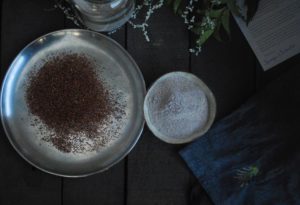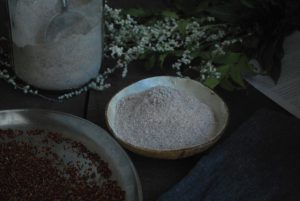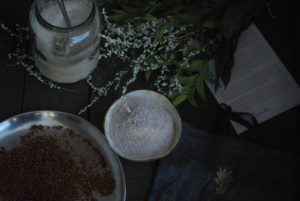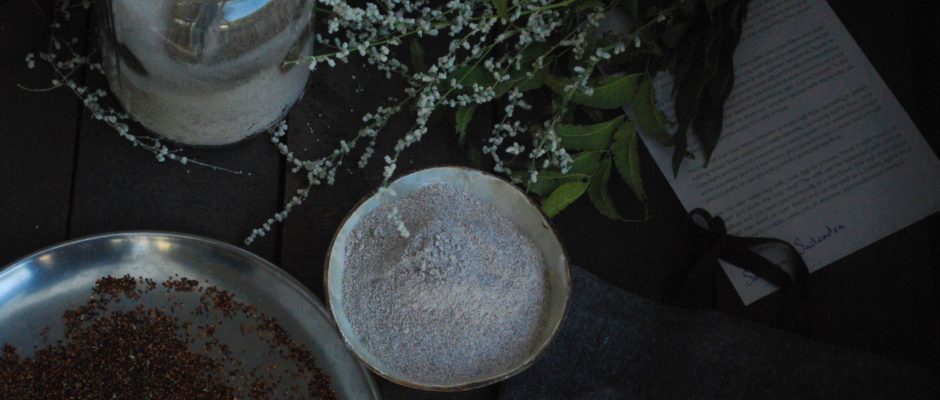Simplicity Coimbatore , Special harvest , Ragi
The importance of the harvest festival has been ingrained into us as early back as my memory goes. It’s not like the significance was explained to us in words, we understood merely by watching.The rituals exhibit a sense of reverence rather than only a celebratory feeling. It is undoubtedly about gratitude , to the land, the hard working farmer and towards a year where the bounty is plenty . Simultaneously it also signifies looking forward to a year without drought or untoward natural calamities ; when all of nature’s elements strike a harmonious balance.
For so many like me , it is vital to take the time out to pay obeisance to the earth and stay connected to that which we sometimes take for granted.
The yearly ritual during Pongal involves a spring cleaning followed by festooning the corners with bunches of neem leaves and poola poo (mountain knots) .This native bouquet is laden with anti bacterial properties and keeps fungus at bay. The heavy brass vessels and new mud pots are prepared by tying freshly harvested turmeric rhizomes around the pot, (known for it’s antiseptic properties) for making the sweet offering comprising of newly harvested rice grains, natural jaggery , ghee, dried fruits and saffron.The home takes on a festive garb with the cow dung washed front yard adorned with the beautiful hand drawn rice flour kolam.(festive designs )
A routine like this is special enough, but this year , the whole mood was enhanced by a rather unique gift.

Delivered to our doorstep was a bag of newly harvested ragi grains with a thoughtful personalised note. It was not just delightful to read but also truly uplifting. A young couple had taken it upon themselves to conduct an experiment using natural farming methods to gain some first hand perspective on sustainable agriculture. The love and dedication that they had no doubt put into this project was rewarded by a good harvest.
This kind of joy is best felt when sharing and that’s exactly what they did. The note went on to give options of how best to use this ancient grain. So many of us think it’s not easy to cook with ragi or rarely go beyond the ragi porridge. The ‘care bundle’ (what I would like to term it) came with specific instructions to make ragi flour , sprouted ragi , sprouted ragi flour , ragi milk , ragi buttermilk and even ragi meal which can be used for baking.
The fact that two young people took time out to understand the damage that is being done to the environment with chemical based farming practices and wanted to see if natural farming is a feasible option for the humble farmer,deserves to be applauded and talked about.
It is exactly this kind of thought process which can beget a sustainable change towards a more natural lifestyle. To start off the Pongal festival with such an inspiring message was so meaningful.
Ragi also known as finger millet in English is one of the most nutritious among our traditional grains. When eaten in the right quantities ,this mustard seed like grain can boost wellness tremendously. Despite it being an indigenous crop, it has declined in cultivation over the past decade. Even though it is known to be hardy and drought resistant , ragi production has seen a drastic reduction.
Nachni (ragi) bread , crackers, cookies are popular in health food stores across the country. “Rain fed ragi “ as my mother always referred to it as,was sown between the months of Jun-July.The crop would be fed by naturally occurring rainfall which added to it’s nutrient profile. Sepetember/October are also months where it can be sown for a spring harvest. When soaked and allowed to sprout, ragi malt as it is commonly known can also be made into malted ragi flour.

The sight and aroma of ragi flour is something which is so comforting. It was the weaning food that we all chose for our babies.The simple act of cooking the ragi porridge brings back so many memories.This grain is so versatile that it can be paired with both sweet as well as salty flavours.
My sister-in-law’s mother makes a delicious ragi pakoda which is best eaten piping hot. With so much being written about food contamination and additives, making our own ragi flour is a better option and is the task of minutes. All it needs is a good exposure to sunlight to make sure there is no moisture and then can be put into the blender jar for powdering.
The ragi grains at home have been made into flour and we can’t wait to add it to our meals ,a few times every week. The woven bag and the note will continue to be a reminder of how this Pongal week began with the gift of ‘a labour of love’. Can’t think of a better way to start off this decade on a sustainable path.



No comments yet.